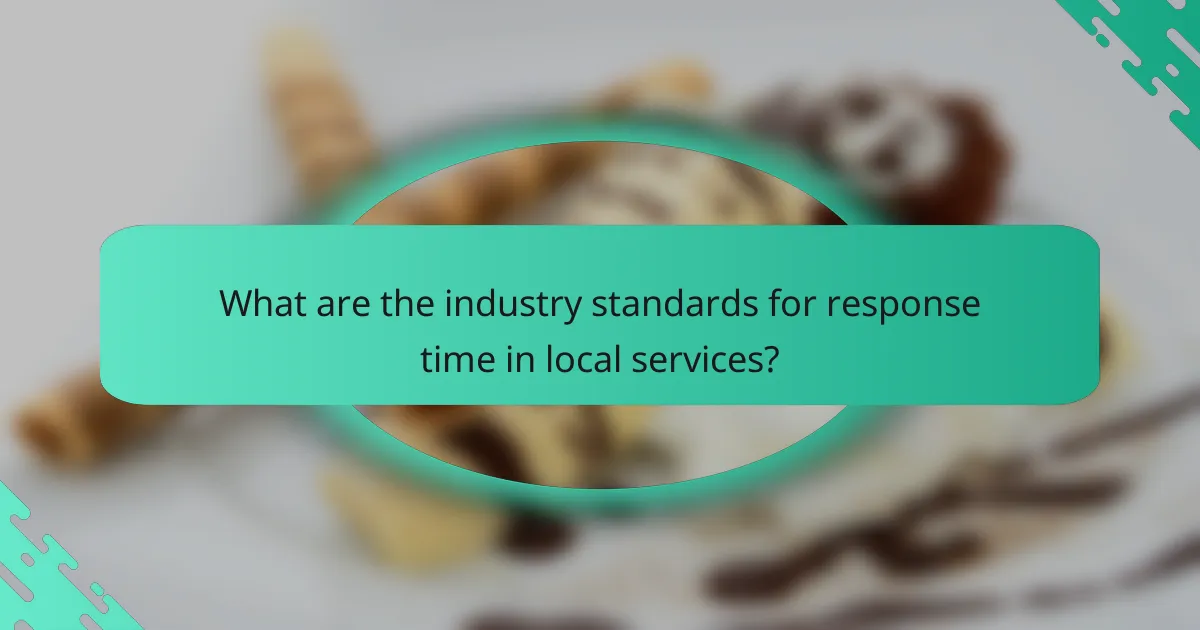Response time plays a vital role in shaping service quality and customer experience, as it directly affects how customers perceive the efficiency of a business. Quick responses can lead to increased satisfaction, while delays often result in frustration and a negative impression. To improve response times, organizations can adopt automated systems, train their staff, and actively seek customer feedback, ultimately enhancing overall service delivery.

How does response time impact service quality in local services?
Response time is a critical factor in determining service quality in local services, as it directly influences customer perceptions and experiences. Faster response times typically lead to higher satisfaction levels, while delays can frustrate customers and diminish their overall experience.
Direct correlation with customer satisfaction
There is a strong link between response time and customer satisfaction. When customers receive prompt replies to inquiries or issues, they feel valued and understood, which enhances their overall experience. In contrast, slow responses can lead to dissatisfaction and a perception that the service provider does not prioritize their needs.
For example, a local restaurant that responds to reservation requests within minutes is likely to receive positive feedback, while one that takes hours may face complaints. Aim for response times within single-digit minutes for optimal customer satisfaction.
Influence on service reputation
Response time significantly affects a business’s reputation in the community. Quick and efficient service builds a positive image, while slow response times can lead to negative reviews and word-of-mouth. In today’s digital age, customers often share their experiences online, making it crucial for local services to maintain a strong reputation.
Local businesses should monitor their response times and actively seek feedback to identify areas for improvement. Aiming for a response time of under 15 minutes for customer inquiries can help maintain a favorable reputation.
Effect on customer retention
Timely responses are essential for customer retention. Customers are more likely to return to a service provider that addresses their concerns quickly and effectively. On the other hand, prolonged response times can drive customers to competitors, leading to a loss of business.
To enhance retention, local services should implement systems to track response times and ensure that staff are trained to prioritize timely communication. Regularly reviewing performance metrics can help identify trends and areas needing improvement, ultimately fostering customer loyalty.

What are the best practices for improving response time?
To enhance response time, organizations should focus on implementing automated systems, training staff effectively, and utilizing customer feedback. These practices can significantly streamline operations and elevate customer satisfaction.
Implementing automated systems
Automated systems can drastically reduce response time by handling routine inquiries and tasks without human intervention. For example, chatbots can provide instant answers to frequently asked questions, allowing human agents to focus on more complex issues.
When implementing automation, consider the balance between efficiency and personalization. While automation can speed up responses, ensure that it does not compromise the quality of customer interactions. Regularly review automated responses to maintain relevance and accuracy.
Training staff for efficiency
Training staff to respond quickly and effectively is crucial for improving response time. Regular workshops and role-playing scenarios can help employees practice handling various customer situations efficiently.
Encourage staff to familiarize themselves with common issues and solutions, enabling them to provide faster resolutions. Setting clear performance metrics, such as response time targets, can also motivate staff to improve their efficiency.
Utilizing customer feedback
Gathering and analyzing customer feedback is essential for identifying areas where response time can be improved. Surveys and direct feedback can reveal customer pain points and expectations regarding response times.
Use this feedback to make informed adjustments to processes and training. Regularly revisiting customer insights can help ensure that response strategies remain aligned with customer needs, ultimately enhancing overall service quality.

How can businesses measure response time effectively?
Businesses can measure response time by utilizing various tools and techniques that provide insights into customer interactions. Effective measurement involves tracking metrics, analyzing data, and conducting regular reviews to ensure service quality and enhance customer experience.
Using customer relationship management tools
Customer relationship management (CRM) tools are essential for measuring response time as they consolidate customer interactions across multiple channels. These platforms can automatically log response times for emails, chats, and calls, providing a comprehensive view of service efficiency.
For example, a CRM might show that response times for email inquiries average around 30 minutes while live chat responses are typically under 5 minutes. This data helps businesses identify areas for improvement and set realistic benchmarks.
Tracking response metrics
Tracking response metrics involves monitoring key performance indicators (KPIs) such as average response time, first response time, and resolution time. These metrics help businesses understand how quickly they are addressing customer inquiries and where delays may occur.
Commonly, businesses aim for first response times within a few minutes for live chat and under an hour for email. Regularly reviewing these metrics allows companies to adjust staffing or processes to meet customer expectations more effectively.
Conducting regular performance reviews
Regular performance reviews are crucial for assessing response time and overall service quality. These reviews should analyze the data collected from CRM tools and response metrics to identify trends and areas needing improvement.
During these reviews, businesses can set specific goals, such as reducing average response times by a certain percentage over the next quarter. This proactive approach ensures that response time remains a priority and aligns with customer satisfaction objectives.

What are the industry standards for response time in local services?
Industry standards for response time in local services typically range from a few minutes to several hours, depending on the type of service provided. Quick response times are crucial for enhancing customer satisfaction and ensuring service quality.
Typical response time benchmarks
Response time benchmarks vary widely across industries. For example, customer service inquiries often expect replies within a few minutes, while maintenance services may aim for a response within one to two hours. Fast food restaurants usually target under 10 minutes for order fulfillment.
In emergency services, such as plumbing or electrical repairs, response times are expected to be immediate, often within 30 minutes. Establishing clear benchmarks helps businesses set customer expectations and improve service delivery.
Variations by service type
Different service types have distinct response time expectations. For instance, healthcare services prioritize rapid responses, often requiring immediate attention for urgent cases. In contrast, retail services may allow for longer response times, typically within a few hours for online inquiries.
Professional services, like legal or financial consulting, often have a more flexible timeline, with responses expected within one business day. Understanding these variations helps businesses tailor their service strategies to meet customer needs effectively.
Regional differences in expectations
Response time expectations can differ significantly by region. In urban areas, customers often expect faster responses due to higher competition and availability of services, typically within 30 minutes to one hour. Conversely, rural areas may have longer acceptable response times, sometimes extending to several hours or even a day.
Additionally, cultural factors influence these expectations. In some regions, promptness is highly valued, while in others, a more relaxed approach to response times is common. Businesses should consider these regional differences when establishing their service standards.

What technologies can enhance response time?
Technologies that improve response time include automated systems like chatbots and mobile applications, which streamline communication and enhance customer engagement. These tools help businesses provide quicker responses, leading to better service quality and customer satisfaction.
Chatbots for immediate assistance
Chatbots are automated programs designed to interact with customers in real-time, providing immediate responses to inquiries. They can handle a variety of tasks, from answering frequently asked questions to assisting with order tracking, significantly reducing wait times.
When implementing chatbots, consider their integration with existing systems and the types of queries they will handle. A well-designed chatbot can operate 24/7, offering support even outside of regular business hours, which is particularly beneficial for global businesses.
However, it’s essential to balance automation with human touch. Some customers may prefer speaking to a human representative for complex issues, so ensure there is an option to escalate conversations when necessary.
Mobile apps for customer engagement
Mobile applications enhance customer engagement by providing a platform for instant communication and service access. They can facilitate features like live chat, push notifications, and easy access to account information, all of which contribute to faster response times.
When developing a mobile app, focus on user experience and ensure that it is intuitive and easy to navigate. Regular updates and maintenance are crucial to keep the app functioning smoothly and to incorporate user feedback for improvements.
Additionally, consider offering incentives for app usage, such as exclusive discounts or loyalty rewards, to encourage customers to engage more frequently and utilize the app for their service needs.


